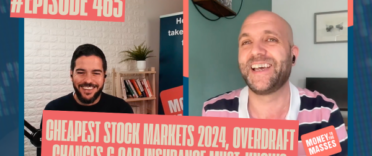The 147th episode of my weekly YouTube show where I discuss what is happening in investment markets and what to look out for. This week I talk about how markets are searching for a direction.
Each show lasts between 5-10 minutes and is aimed at DIY investors (including novices) seeking contemporary analysis to help them understand how investment markets work.
Subscribe to my YouTube channel to receive my weekly analysis of investment markets or alternatively, you can listen via my weekly Midweek Markets podcast below.
Midweek Markets weekly podcast
Other ways to watch, listen and subscribe
You can listen to other episodes and subscribe to the show by searching 'Money to the Masses' on Spotify or by using the following links:
Abridged transcript - Midweek Markets episode 147
This is the last Midweek Markets show for two weeks as I take a small break over Easter.
But to start this week’s show it’s worth highlighting a few key points that I raised last week which included:
- That in the coming weeks we will find out whether the breakouts in equity markets and bond yields markets will hold.
- That equity markets will soon have to navigate another corporate earnings season which will include the impact of the war in Ukraine on corporate profits. That’s a potential headwind.
- On the S&P 500, 4500 remained an important level for the index to remain above if the rebound is to continue. It’s 200 day moving average sits just below this.
- For the DAX the equivalent support level was still 14500.
- The 2.22% level on the 10 year US treasury yield is important as a drop back below there (which means bonds are rising in value) would mean the multi-decade downtrend in bonds will likely resume as it did in 2019.
- Finally, I noted that the volatility in bond markets had picked up significantly while at the same time the S&P 500’s VIX had tumbled back below its long term average of 20. That in itself is unusual and historically we often see equity market volatility pick up in response whenever this divergence occurs. That of course would be for US equity markets.
All of these things either remain in play or came to fruition over the last 7 days. Let's take the last one as an example, on Wednesday the VIX broke higher (up from 19 to 24) after more hawkish soundbites from US Federal Reserve officials. The market had remained steadfast in its belief that the Fed (and other key central banks) woul not raise interest rates as fast as first feared and/or would be forced to begin cutting interest rates again once economic growth faltered.
But on Wednesday, the release of the minutes from March’s Fed meeting suggested that the central bank would raise interest rates and unwind its QE programme more aggressively than the market had thought. This finally gave the market pause for thought and the S&P 500 closed the day below 4500 to sit near its closely watched 200 day moving average at 4490. To the upside, the market needs to break back above 4500 and then 4600 to regain the upside momentum if we are to head back to all-time highs and put this latest pullback in equities behind us.
It didn’t help that on the same day Deutsche Bank became the first major investment bank to state that it anticipates a US recession in 2023. Not only that but it also expect equity markets to fall by 20% by next summer while the 10 year US treasury yield hits 3.3 this year.
Meanwhile over in Europe, the German DAX tumbled as fears that the European Central Bank would have to hike its main interest rate by 1.8% in just 18 months (which would be the fastest hiking cycle since 2009 - in the aftermath of the financial crisis). The DAX crashed below 14500 and sits at 14160, down 3.8% since the start of the week. The 14500 level remains an important one to keep an eye on over the coming weeks. Does the weakness we’ve seen in European and US stocks mean that the rebound is over? Not necessarily but it does complicate things, unless both turnaround swiftly.
The FTSE 100 remains strong and in its uptrend that started back in November 2020 but is currently trading between 7300 and 7600. It currently sits at 7583 as I make this show, but we really want to see it decisively break above 7600 and the February high of 7672 if we are to revisit the all-time high of 7877 which we saw in 2018. Meanwhile bonds continue their dire start to 2022, by way of example the the 10 year US treasury yield hit 2.641% this week - it’s highest level in almost three years in response to the Fed rate hike fears.
The upshot is that bond and equity markets remain finely poised, waiting for the catalyst to move decisively higher or lower. The potential sources of that catalyst are numerous - including the war in Ukraine and geopolitics but also upcoming corporate earnings reports in April, central bank rhetoric, China’s covid ongoing outbreak to name just a few. April is historically a strong month for equity markets but given the backdrop, it’s unlikely to be a smooth ride even if ends up being a positive one.



